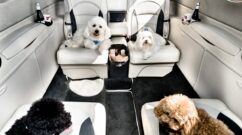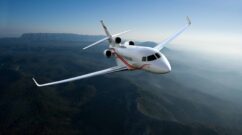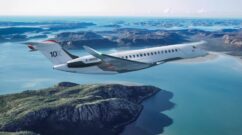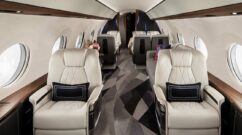Time is not just a scarce resource; it’s one of the most strategic assets of modern business. In an economic context where every opportunity can make a difference, the ability to act quickly – to be in the right place at the right time – can alter the course of a negotiation, speed up decision-making or secure a key partnership. Business travel, long managed as a simple support function, is now at the heart of executive team performance.
When a trip involves several countries, high-level contacts and tight deadlines, business aviation becomes a concrete lever for efficiency and anticipation. Far from “bling-bling” representations, taking a private jet is not a question of image or prestige. Above all, it’s a working tool that allows you to preserve what’s essential: useful time, flexibility and optimal preparation of decisions. In fact, Capital magazine estimates that a CEO who takes around 30 trips a year can save the equivalent of a month’s work by preferring private jets – a clear demonstration of the stakes involved in saving time.
This case study illustrates how AEROAFFAIRES, an airline broker for over 30 years, supported the CEO of a European group specializing in sustainable mobility technologies, in preparing and carrying out a strategic tour of Europe. A mission spread over three days, three countries, three different challenges, with one central need: to save time.
Background to the air travel mission with AEROAFFAIRES
The mission awaiting this executive is decisive on a European scale. The client is Managing Director of a French industrial group operating in the low-emission mobility systems sector. His company has several production sites in Europe, maintains technological cooperations with specialized suppliers, and regularly participates in international think tanks on energy and innovation. In other words, his schedule is meticulous and his trips often strategic.
For this particular tour, the program is particularly dense, with three main objectives:
- A visit to a partner plant in Stuttgart to validate the ramp-up of a new production line. On site, the aim is to verify that this industrial site will be able to increase its volumes without a hitch, an essential condition for the forthcoming launch of a new product.
- Meet with a strategic supplier in Milan to conclude a multi-year supply agreement. This supplier delivers a key component, and securing a multi-year contract will guarantee the Group’s supply chain, avoiding shortages and price fluctuations.
- Speaking in Paris at an international forum on energy innovation, attended by public decision-makers and investors. The company’s CEO is invited to speak at the event, giving the company high visibility and an opportunity for high-level networking.
Three critical meetings, in three distinct environments (industrial, business, institutional), over three consecutive days – with very tight time constraints. The management team naturally begins by investigating commercial air links to connect these milestones, but very quickly the limitations become apparent.
Constraints identified with commercial flights:
- Mandatory connections. There is no direct route that can efficiently link Stuttgart, Milan and Paris within the allotted time. Executives would have to multiply stopovers and aircraft changes, with the risk of missing a connection in the event of delays.
- Unsuitable schedules. The scheduled flights available on the dates requested do not correspond to the requirements of the meetings. For example, the only morning flight from Paris to Stuttgart arrives too late for the 10 a.m. factory visit, forcing you to leave the day before and spend an extra night on site.
- Time lost in terminals. Even when optimized, every commercial flight has its share of waiting: check-in, security checks, boarding, disembarking, baggage reclaim… All in all, hours “lost” that lengthen the working day.
- Increased fatigue. Back-to-back commercial flights in three days, with early mornings, transfers and the stress of deadlines, would exhaust the executive, to the detriment of his or her effectiveness in key meetings.
- Risk of unforeseen events. Flight delays or cancellations, strikes, lost luggage – all uncontrollable factors that could derail the tour’s critical agenda.
The math is clear. If the company were to keep to its commercial aviation schedule, it would lose the equivalent of two working days in transit and waiting time alone. In other words, two whole days when the manager and his team would not be productive on their files. Between missed connections to avoid and extra hotel nights, the classic itinerary would considerably dilute the efficiency of the mission.
The executive assistant, in charge of the General Manager’s diary, plays a decisive role here. Recognizing the risk of inefficiency, she looked for an alternative. She contacted AEROAFFAIRES, a business aviation broker with over thirty years’ experience, to study a tailor-made solution. The request was received late in the afternoon… and the answer was not long in coming.
Intervention by AEROAFFAIRES, Europe’s leading airline concierge service
Analysis of the request
As soon as they are contacted, the AEROAFFAIRES team dedicated to the customer looks at the key parameters of the trip to be organized:
- Number of passengers: The executive is traveling with a few colleagues (4 to 6 people). The aircraft must be able to accommodate them comfortably and allow them to work on board.
- Multi-destination itinerary: Several stages (Paris – Stuttgart – Milan – return to Paris) in a short time, with successive flights and the aircraft stationed on site during each meeting.
- Total travel time: Three intense days, with aircraft and crew permanently on the move. Coordination must be meticulous to link each departure, flight and arrival at the right time.
- Confidentiality required: Sensitive technical documents and contracts on board – absolute discretion is required to work serenely during flights.
- Time flexibility: The schedule must be able to be adjusted up to the day before, depending on the progress of negotiations (e.g., postpone a take-off if a meeting is running over).
- Ground coordination: At each stage, a private driver waits on the tarmac to take the team directly to the meeting, bypassing the public terminals.
Thanks to this analysis, a coherent tailor-made solution is proposed in less than two hours.
Choice of aircraft
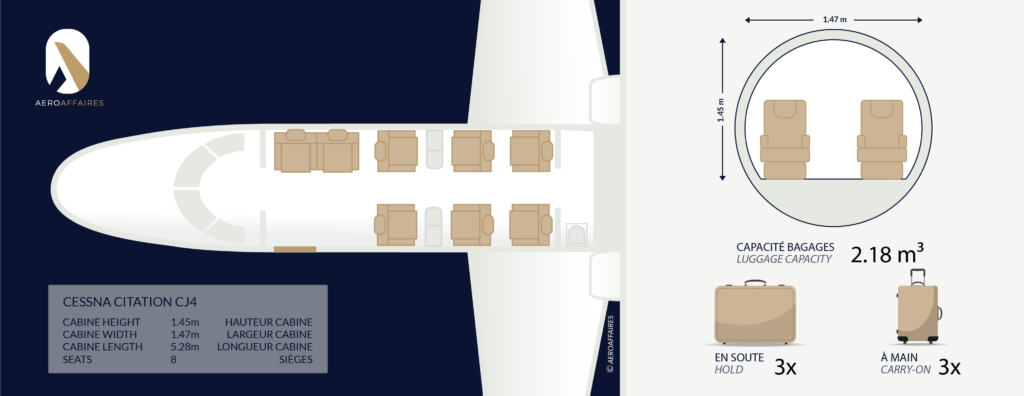
The mission calls for a light jet that is both comfortable and has sufficient range for direct, non-stop intra-European flights. AEROAFFAIRES proposes the Cessna Citation CJ4. This business jet offers a number of advantages in line with the needs identified:
- Capacity: up to 6 passengers, ideal for the CEO and his close-knit team.
- Quiet cabin: a quiet, soundproofed interior, ideal for undisturbed in-flight work. The spacious cabin features reclining leather seats, fold-out computer shelves and large windows for natural lighting.
- Extended range: around 3,700 km of range, placing the CJ4 among the best in its class and allowing direct flights between Paris, Stuttgart and Milan without refuelling. This more than covers the needs of multi-city travel.
- Airport versatility: the CJ4 can use relatively short runways (from ~1,500 m for take-off). This means it can land at secondary business airports, closer to industrial sites or city centers, avoiding large, congested hubs.
The customer quickly validates this option. Accustomed to travelling via Paris-Le Bourget airport, they appreciate being able to access the aircraft directly, without queues or a labyrinthine route through a commercial terminal. At Le Bourget, Europe’s leading business aviation airport, it generally takes just 15 minutes from arrival at the private terminal to jet take-off, whereas a scheduled flight would require two hours’ notice. For this executive, this time saving and the discretion offered from the moment of boarding are a decisive advantage.
Complete logistics organization: AEROAFFAIRES door-to-door service
AEROAFFAIRES then coordinates the entire mission in a comprehensive manner, paying attention to the smallest logistical details:
- Tailor-made flight plan: each flight’s schedule is adjusted exactly to the requirements of the meetings. For example, if the factory visit ends at 12 noon, the jet will take off shortly afterwards for Milan, avoiding any unnecessary waiting. Conversely, the plane won’t leave until the team is ready, offering a degree of flexibility unavailable on scheduled flights.
- Reserved airport slots: landing and take-off slots are obtained in advance from Stuttgart and Milan airports, to ensure that the plane can depart and arrive at the scheduled times, even in heavy traffic. No risk of flying in circles over a congested airport.
- Chauffeur-driven car on the tarmac: as soon as the aircraft lands in Stuttgart or Milan, a private vehicle awaits the team at the foot of the plane.
- Personalized on-board service: precise catering is provided in the aircraft. Light meals, taking into account the executive’s allergies and preferences, are served on board, so you can eat without wasting time. No heavy meals are imposed: the team can choose to work or rest during the flight.
- In-flight Internet connection: the jet is equipped with high-speed Wi-Fi, ensuring that the executive and his or her staff remain continuously connected. They can send emails, take part in video conferences or fine-tune a presentation during the journey, just as if they were in the office, all in a confidential and secure environment.
The aim of these arrangements is not to multiply luxury services, but to eliminate all unnecessary friction. From flight planning to ground transportation, everything is orchestrated to ensure that each transition is as seamless as possible. AEROAFFAIRES takes care of coordinating everything, allowing the executive to concentrate solely on his or her business issues. As they put it: “With business aviation, you stay focused on your mission, and don’t worry about the logistics of your trip”. This philosophy guides the organization of the mission.
Mission schedule
Day 1 – Paris ✈ Stuttgart
Departure: The private jet takes off from Le Bourget at 7:30 am. Boarding is fast and smooth, with no unnecessary waiting: as soon as the executive arrives at the business terminal, he boards and the plane leaves the tarmac at the scheduled time.
Arrival: At 9.10am, the aircraft lands in Stuttgart. A private driver greets the team at the foot of the plane and immediately takes them to the industrial site, where the tour begins at around 10am.
Site visit: The meeting goes off without a hitch. For two hours, the partner’s engineers and the Managing Director examine the new production line and approve its ramp-up. Thanks to his punctuality and concentration, the CEO obtains all the necessary information and leaves confident that the additional production capacity will be delivered.
At the end of the day, the first objective is achieved without excessive fatigue. The team takes advantage of its free evening to rest or prepare reports, before tackling the rest of the mission.
Day 2 – Stuttgart ✈ Milan
Morning: On the second day, no race against the clock to catch a commercial flight. The executive can manage a few files from Stuttgart in the morning, with the private plane just waiting for his signal to leave.
Take-off for Milan: In the early afternoon, the jet leaves Stuttgart for Milan (approx. 1-hour flight). During the journey, the team finalizes its negotiation strategy in the calm of the cabin and the Internet connection. The final adjustments to the supply contract are ready for presentation on landing.
Arrival and meeting: The CJ4 lands directly at Milan-Linate airport. Within minutes, the team reaches the strategic supplier’s headquarters. The afternoon is devoted to negotiating the multi-year contract. Well-prepared and with no time pressure (the return flight is scheduled for the following day), the manager engaged in constructive discussions. As a result, an agreement in principle was reached at the end of the day, with each party having been able to discuss matters in good conditions.
In the evening, the team stays in Milan. They can breathe a sigh of relief and fine-tune their speeches for the next day’s forum, rather than endure a late return journey. A good night’s sleep prepares them for the final leg.
Day 3 – Milan ✈ Paris (forum)
Return flight: Early in the morning, the plane takes off again from Milan. At 8:30 it lands at Paris-Le Bourget. A vehicle is waiting on the tarmac to take the group to the forum, which starts in the morning.
Intervention at the forum: At the end of the morning, the CEO takes to the stage in front of public decision-makers and investors. He delivers his message clearly and enthusiastically – without a trace of fatigue to mar his performance. His speech hits the nail on the head, enabling him to make valuable contacts at the lunch that follows.
Closing: At the end of the afternoon, the mission ends with a return to the company’s headquarters. The three initial objectives had been achieved without a hitch. The manager returns to his team the following day, ready to capitalize on these successes, without needing to recover from the long hours of travel.
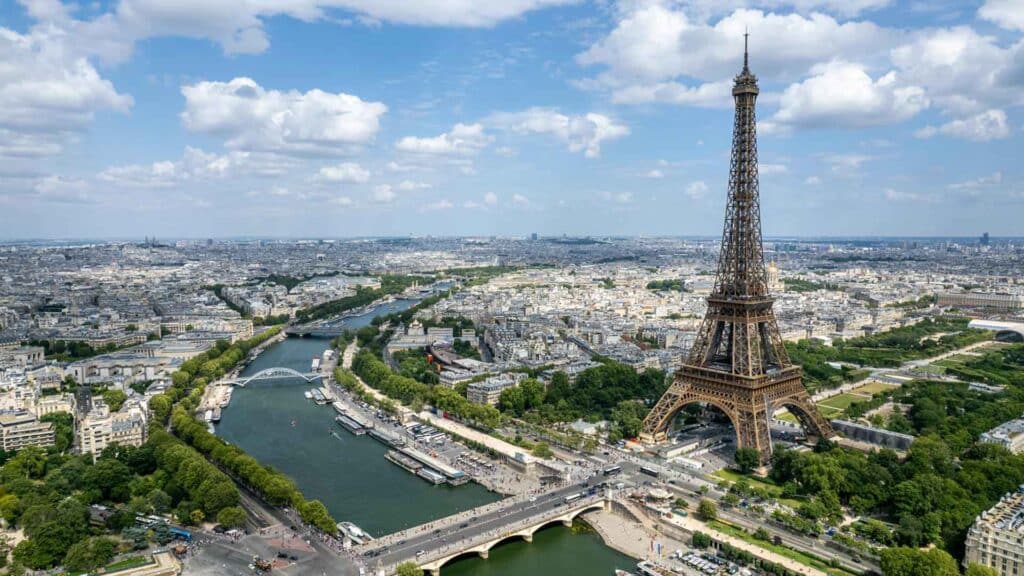


Observed results
Time saved: By opting for business aviation, the executive has saved the equivalent of two working days that would otherwise have been lost in travel and waiting. These hours were not simply saved on paper: they were reinvested in strategy, preparation and analysis throughout the mission. Rather than being stuck in an airport or on an airliner without being able to make any progress on his files, the General Manager used this time to fine-tune his negotiations and refine his decisions. Over the whole tour, it can be estimated that some 15 to 16 hours of transit time were avoided thanks to the private jet – useful time that directly contributed to the success of the three meetings.
Work continuity: The choice of the private jet ensured remarkable work continuity throughout the trip. The spacious and silent cabin of the Citation CJ4 acted as a real flying meeting room, allowing the team to hold work sessions in mid-air. Documents spread out on the table, confidential calls made from the club seat, last-minute corrections to a contract: none of this would have been possible on a standard commercial flight. Thanks to the Wi-Fi connection and the private environment, the executive remained productive between each stage, where others would have suffered phases of forced inactivity. Studies have even shown that the productivity of executives on the move can be multiplied by 5 to 7 when the flights are made in business aviation.
Impact on the quality of exchanges: Arriving rested and perfectly prepared has a direct impact on the quality of meetings. Unaffected by the stress and fatigue usually associated with fast travel, the executive was able to approach each meeting with maximum concentration and a positive attitude. This had an influence on the tone of the negotiations: in both Stuttgart and Milan, discussions took place in a constructive atmosphere, with no nervousness or haste due to possible delays. Similarly, at the forum in Paris, the speaker’s fresh approach to the subject made his speech clearer and more convincing. All in all, the executive was able to give his all at every stage, resulting in more precise decisions and a better ability to listen to his interlocutors.
Control of image and confidentiality: Business aviation also enabled us to keep control of the story surrounding this trip. Unlike a commercial trip, this journey remained totally under the radar: no presence in the crowded boarding lounges, no chance of bumping into a competitor or a curious journalist during a connecting flight. This organizational discretion was a major asset in preserving the confidentiality of ongoing negotiations. More generally, private jet travel provides almost absolute protection against prying eyes or industrial espionage. For this mission, the executive was able to travel incognito, without attracting media or speculative attention.
What the management team remembers
For the CEO and his team, this successful tour highlights that the added value lies not only in the aircraft itself, but above all in the way the mission was orchestrated from start to finish. Here are the lessons they learned:
- A dedicated team: Having a single, responsive contact at AEROAFFAIRES made all the difference. From the first contact to the final feedback, this advisor followed the file and adjusted the smallest details in real time. Management particularly appreciated being able to count on a 24/7 service, aware of the strategic importance of each flight.
- Anticipation of contingencies: Nothing was left to chance in the preparations. Secure airport slots, plan Bs in case of bad weather, flexible schedules planned from the outset… This ability to anticipate reassured the executive, who knew that in the event of the unexpected, solutions were already in place. This contrasts with traditional travel, where the slightest grain of sand (delay, strike) can jeopardize everything.
- Organizational fluidity: Finally, the fluid sequence of events was seen as a major asset. The schedule for each meeting could be respected or adapted without any headaches, which eliminated a huge mental load. Not having to worry about logistics enabled the Managing Director to stay focused on his decisions, and his team to remain mobilized on the content rather than the container. In short, the flexibility of the system amplified collective efficiency.
In the words of the executive assistant who orchestrated the trip:
“The difference is in the details. Being able to adjust the departure time from Milan by forty minutes the day before enabled us to finalize negotiations without rushing. This level of flexibility makes a real difference to the manager’s efficiency
Comparison table: Business aviation vs. commercial flights
| Criteria | Commercial flights (Paris Stuttgart Milan Paris) | Business aviation with AEROAFFAIRES | Impact for the executive |
|---|---|---|---|
| Total travel time over 3 days | approx. 21 h cumulative travel time (transfers, boardings, connections) | approx. 7 h 30 of cumulative travel time | 2 working days saved |
| Timetable | Fixed, depending on scheduled flights | Adapted to the manager’s actual schedule | Greater flexibility and peace of mind |
| Privacy | Low, public areas | High, dedicated private terminals | Protection of documents and conversations |
| Intra-European connections | Sometimes with stopovers or connections | Direct | Maintain focus between meetings |
| Meeting preparation on the move | Difficult, unsuitable environment | Quiet cabin, in-flight connection | Continuous work without breaks |
| Coordination on the ground | To be organized separately in each city | Drivers and transfers managed by AEROAFFAIRES | Elimination of logistical friction |
| Physical impact and mental workload | Increased fatigue, variability of hazards | Smoother movements, rested arrival | Improved quality of exchanges |
Conclusion
In this context, business aviation is not a comfortable caprice, it’s a real tool for optimizing working time and decision-making. As this case study shows, for a manager faced with a critical international agenda, chartering a private jet turned a constraint into a competitive advantage. All three strategic objectives could be achieved without compromise, where standard commercial travel would probably have forced choices or caused detrimental delays.
AEROAFFAIRESwith over 30 years’ experience in the private aviation sector, we regularly assist executives, executive assistants, project managers, industrial groups and institutional players with their strategic travel needs. Since its creation in 1991, the broker has organized over 45,000 tailor-made flights, carrying more than 120,000 business passengers worldwide. Each mission is unique and meticulously prepared: everything is designed to reduce friction and preserve what really counts for the customer – his time, his availability, his preparation and his safety.
Ultimately, using business aviation in a situation like this is not about taking the easy way out: it’s about investing inefficiency. The executive in our case study was able to live through three intense days constantly at 100% capacity, and his company is already reaping the rewards in terms of projects brought to fruition and decisions taken more quickly. This scenario is repeated today in many organizations that understand that time saved on travel is time reinvested in value creation.
Why choose business aviation for executive travel?
Because it preserves useful time.
A private flight connects directly with the destinations you need, with no connections, no waiting in terminals and none of the hazards associated with scheduled flights. This allows executives to hold several meetings in a day, while remaining available and focused. The cabin becomes a work space, where you can prepare, debrief and adjust continuously. Here, the private jet is a performance tool, not a prestige symbol.
Who takes care of transfers between the airport and the meeting venue?
AEROAFFAIRES coordinates all ground transfers.
A private driver is positioned at the foot of the aircraft on arrival.
The team is driven directly to the venue, without wasting time or passing through terminal → cab → hotel → meeting point.
How much does a private flight cost for a Paris – Stuttgart – Milan – Paris tour?
Depending on the aircraft chosen, ground organization and schedules, the budget is generally between €12,000 and €22,000 for the entire route.
This amount covers :
- aircraft and crew,
- airport taxes,
- parking,
- runway transfers,
- 24/7 operational reactivity.
A precise quote is provided before any commitment is made.
How long does it take to organize a private flight?
On average, between 30 minutes and 2 hours, depending on the complexity of the trip.
AEROAFFAIRES operates on a continuous basis: the request is received, analyzed, and a detailed quote is sent immediately. In an emergency, an aircraft can be ready very quickly at Le Bourget, Geneva, Milan-Linate or Zurich-Kloten.
Is it really cost-effective compared with commercial flights?
The comparison isn’t just based on ticket price.
It’s about the value of time saved.
On a multi-city tour of Europe, business aviation can save the equivalent of one or two working days. These hours are reinvested in reflection, negotiation and decision-making. The cost of a private flight is therefore measured against its impact: securing contracts, optimizing work rhythm, reducing fatigue, maintaining the executive’s concentration.
To organize a similar mission: contact our advisors 24/7:
- ✉️ charter@aeroaffaires.com
- 🇫🇷 +33 (0)1 44 09 91 82
- 🇨🇭 +41 22 355 06 24
- 🇺🇸 +1 845 373 3456
- 🇬🇧 +44 84 4986 0547
